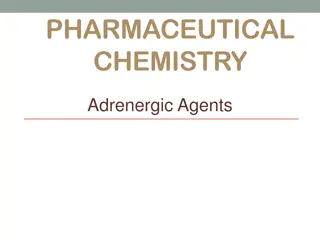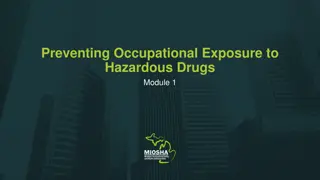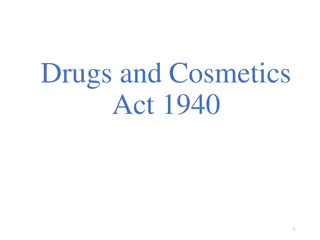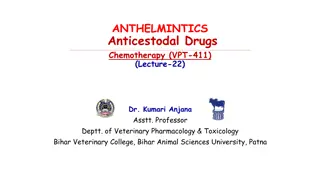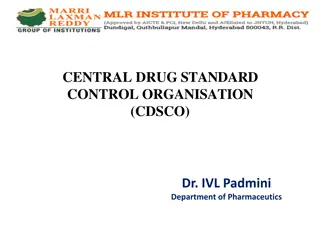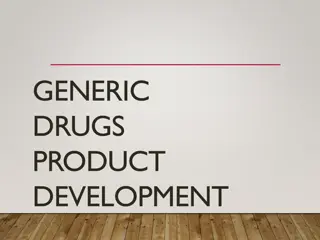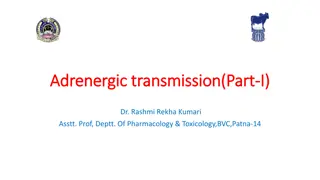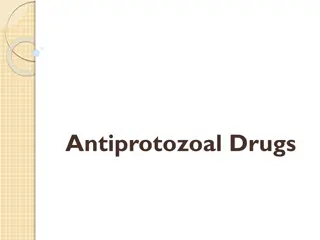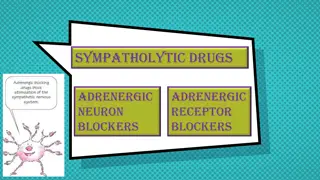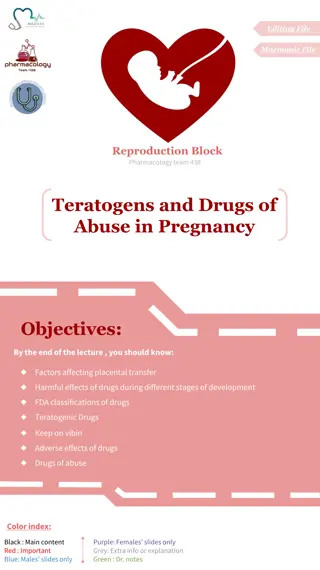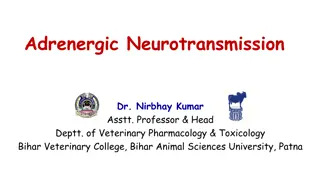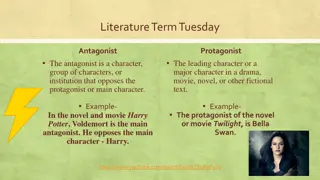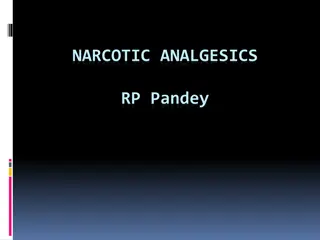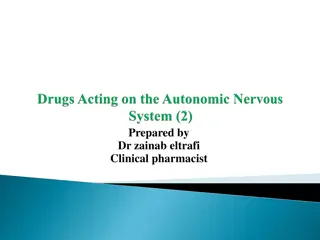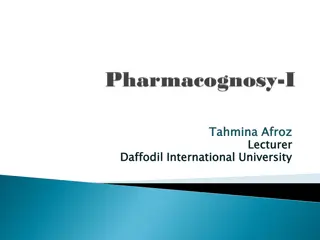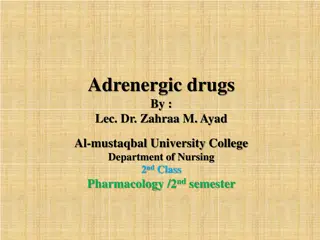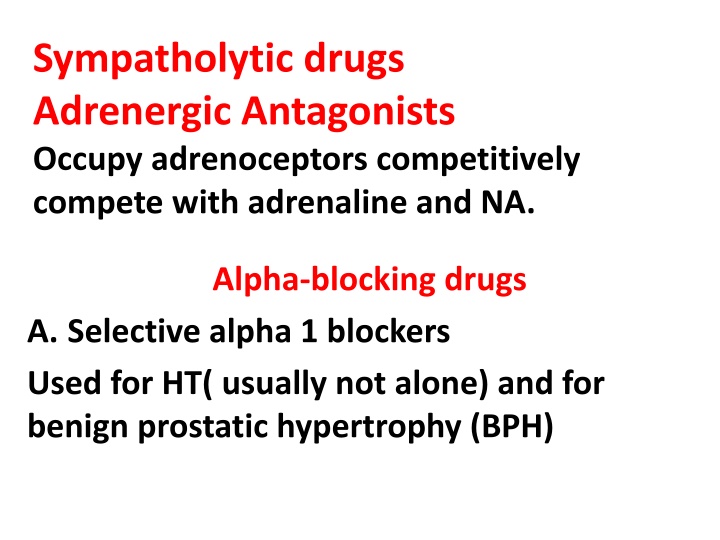
Sympatholytic Drugs - Adrenergic Antagonists Overview
Sympatholytic drugs, such as adrenergic antagonists, competitively occupy adrenoceptors, blocking the action of adrenaline and Noradrenaline. Alpha-blocking drugs, specifically selective alpha-1 blockers, are commonly used for conditions like hypertension and benign prostatic hyperplasia (BPH).
Download Presentation

Please find below an Image/Link to download the presentation.
The content on the website is provided AS IS for your information and personal use only. It may not be sold, licensed, or shared on other websites without obtaining consent from the author. If you encounter any issues during the download, it is possible that the publisher has removed the file from their server.
You are allowed to download the files provided on this website for personal or commercial use, subject to the condition that they are used lawfully. All files are the property of their respective owners.
The content on the website is provided AS IS for your information and personal use only. It may not be sold, licensed, or shared on other websites without obtaining consent from the author.
E N D
Presentation Transcript
Sympatholytic drugs Adrenergic Antagonists Occupy adrenoceptors competitively compete with adrenaline and NA. Alpha-blocking drugs A. Selective alpha 1 blockers Used for HT( usually not alone) and for benign prostatic hypertrophy (BPH)
a. Prazosin Blocks 1 receptors causing vasodilation. Uses: Hypertension, BPH SE: -Postural hypotension (dizziness). - First dose effect: Exaggerated postural hypotension causes syncope (fainting). Small dose at bedtime to reduce such effect. -reflex tachycardia, nasal congestion, inhibition of ejaculation.
b. Doxazosin Selective 1 blocker, given once daily, t1/2 = 8h. The first dose effect is much less marked, although it is still advisable to start patients with small dose. Uses 1.hypertension 2.benign prostatic hypertrophy Adverse effects Postural hypotension, reflex tachycardia, nasal congestion, inhibition of ejaculation
c. Tamsulosin Tamsulosin slective 1A blocker Has less effect on blood vessels ( 1B), more selective for bladder neck and prostate and is the best for BPH. Selective 2-blockers Yohimbine is 2- selective competitive antagonists. Used primarily in research applications. Obsolete use for erectile dysfunction
Non-selective alpha blockers Phentolamine Competitive non selective alpha blocker. Used for hypertensive crisis of phaeochromacytoma. Produces greater reflex tachycardia than selective 1 blockers, why? ( 2 blocking) Phenoxybenzamine Irreversible uncompetitive non selective alpha blocker. Effect last 2 days. Used in phaeochromacytoma.
Adrenaline reversal effect All -adrenergic blockers reverse agonist actions of adrenaline (vasocostric. & HT). Adrenaline has significant 2 agonist effect (vasodilatation & hypotension). Therefore, in the presence of blocker especially non-selective 1 &2 ?, the blood pressure decreases in response to adrenaline.
MCQ 70 year old patient was recently diagnosed as hypertensive. He got fall and hip fracture after taking his treatment. The most likely drug is: A. Prazosin B. Methyldopa C. Tamsulosin D. Metoprolol
MCQ A 70 year old man with overflow incontinence due to his enlarged prostate. Which of the following drugs would you suggest without significant effect on his BP? A. Prazosin B. Tamsulosin C. Labetalol D. Doxazosin
MCQ 45 years old hypertensive patient is well controlled on an -blocker. The patient received adrenaline for severe attack of asthma. Then he developed hypotension. This reversal effect of adrenalin is due to its effect on: A. 1 B. 2 C. 1 D. 2
MCQ 45 years old hypertensive patient is well controlled on an unknown drug. The patient received adrenaline for severe attack of asthma. Then he developed hypotension. The most likely unknown drug is: A. blocker B. agonist C. agonist D. blocker
Beta adrenergic antagonists Beta-blockers Block receptors Pure antagonists or with partial agonist Reduce heart rate and contractility and then COP and O2 consumption. Decrease renin secretion More evident on exercise than at rest
Classification of Beta blockers according to pharmacokinetic properties: 1. Lipid soluble: Propranolol, metoprolol - Undergo extensive first pass metabolism, large Vd ,cross cell mb and enter CNS readily 2. Water soluble: Atenolol - Less liver metabolism, excreted unchanged by kidney, prolonged effect in renal failure. - Less distribution and penetration to CNS
Intrinsic sympathomimetic (partial agonist) Pindolol have both antagonist and weak agonist action. Cause less fall in resting HR, less effective in angina. - Less rebound effect on withdrawal, less up- regulation of receptors. - Abrupt withdrawal of blockers causes severe tachycardia due to up-regulation of receptors. With dangerous effect in angina. Pindolol causes less withdrawal effect?.
Classification according to receptor selectivity: 1. 1 selective (cardio-selective): atenolol, metoprolol, bisoprolol, nebivolol (A-N) - High affinity to cardiac B1 receptors at low dose 2. Non-slective blockers: propranolol, oxprenolol, pindolol, timolol (O-W) 3. Non-selective -blokers with -blocker: labetalol, carvedilol
Nebivolol has vasodilating action in addition to dose-dependent 1- selective antagonism (release of nitric oxide from vascular endothelium)
The differences between selective and non-selective blockers: 1 blockers cause less bronchoconstriction. 1 blockers can be used in diabetics Non-selective blockers more lipid disturbances Both classes can precipitate acute heart failure Selective blockers bisoprolol, metoprolol as well as carvedilol: used for stable chronic HF.
MCQ The following beta blocker is cardioselective: A. Propranolol B. Oxprenolol C. Carvedilol D. Timolol E. Bisoprolol
Clinical uses of beta blockers CVS: angina pectoris, hypertensio, myocardial infarction, arrhythmias, chronic stable heart failure Endocrine: hyperthyroidism CNS: anxiety, migraine prophylaxis, essential tremor, alcohol and opioid withdrawal. Eye: glaucoma (timolol eye drops)
Adverse effects of blockers 1. Bronchoconstriction 2. Acute cardiac failure 3. Exercise intolerance 4. Cold extremities, intermittent claudication 5. Reduced metabolism and drug elimination 6. Hypoglycemia in non-selective Delayed recovery from hypoglycemia patient may miss warning symptoms(anxiety, palpitation) except sweating?. (cholinergic) 7. Intrauterine growth retardation but not teratogenic
MCQ 75-year-old patient with multiple comorbidities is to receive a -blocker. For which of the following conditions are -blockers are contraindicated? (A) Acute arrhythmias during surgery (B) Angina pectoris (C) Chronic heart failure (D) Hypertension (E) Recurrent hypoglycemia in diabetes blockers mask the signs of hypoglycemia and are potentially hazardous in diabetic patients.
What is the role of -blockers in HF? -blockers decrease myocardial contractility (negative inotropic) and may worsen acute/unstable heart failure. blockers is recommended for chronic stable HF. blockers was shown to improve survival in heart failure & reduce risk of death by arrhythmias. This seems to be due to the following effects: 1.blocking the overactive sympathetic activity 2.Reverse/prevent cardiac remodeling & hypertrophy. 3. Reduce renin release Commonly used -blockers in HF include carvedilol, bisoprolol and metoprolol.
Why non-selective blockers are better to be avoided in diabetic patient ? 1. Patients may miss warning symptoms (anxiety, palpitation) except sweating. 2. blockers glycogenolysis & glucagon ( hypoglycemia) 3. Prevent the counter-regulatory effects of catecholamines 4. Delayed recovery from hypoglycemia. 5. Non-selective blockers cause more lipid disturbances. triglycerides, HDL
Propranolol (Inderal) Non-selective, t1/2 3-6 hrs Lipid sol., extensive fist pass met. Reduce HR, contractility and conduction. Suppress renin Bronchoconstriction Vasoconstriction Inhibit glycogenolysis ( causing hypoglycemia)
Therapeutic uses of propanolol Hypertension Angina pectoris Cardiac arrhythmias Myocardial infarction Migraine prophylaxis Stage fright
Adverse effects of propranolol Bradycardia, AV block, HF Rebound cardiac effect on withdrawal Bronchocostriction Inhibition of glycogenolysis (hypoglycemia) Depression, insomnia, nightmares
MCQ About beta blockers, all the following are true except. A. Causes exercise intolerance . B. May induce bronchocostriction . C. May induce renin release . D. Missing warning symptoms of hypoglycemia. E. Propranolol is exposed to extensive first pass metabolism.
Atenolol (Tenormin) Cardioselective, t1/2 6-9 h (once daily) Water sol, 90% excreted by kidney Less CNS effect, Less bronchocostriction Not interfere with glycogenolysis Metoprolol Cardioselective, t1l2 3-4 h (twice daily) Moderately lipid sol. Timolol: non-selective, topical to decrease IOP in glaucoma. Decrease aqueous humor production
Labetalol and Carvedilol Combined beta and alpha 1 blockers Peripheral vasodilation, reduce BP Carvedilol useful in HF. Shown to reduce mortality in heart failure. Labetalol useful in emergency HT and HT in pregnancy
MCQ Which of the following B-blockers would you suggest for female patient with HT and less likely to worsen her asthma?. A. Propranolol B. Metoprolol C. Labetalol D. Oxprenolol
MCQ Before prescribing a beta-blocking drug, you should ask the patient for having the following problems except: A. Diabetes mellitus B. Bronchial asthma C. Tremor D. Heart failure E. Exercise intolerance

